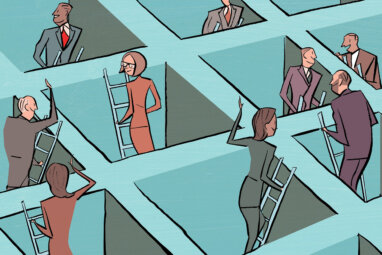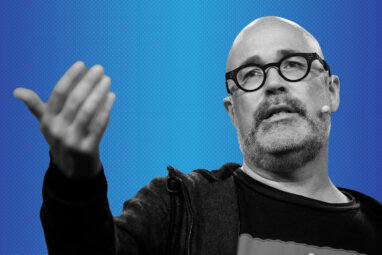CEOs Can Make (or Break) an Organization Redesign
Changing processes and structures requires full-on CEO engagement, but many CEOs have difficulty staying in control throughout the process.

Dan Page/theispot.com
One of a CEO’s essential responsibilities is leading the effort to reconfigure their organization after recognizing that its structure is no longer optimal for creating and delivering value. Some redesigns are major companywide overhauls, such as Procter & Gamble’s creation of six industry-based sector business units in 2019, which its CEO described as “the most significant organization change we’ve made in the last 20 years.”1 Other redesign efforts have a narrower scope, focusing on a particular division, function, or issue.
For a CEO, organization redesign is different from other large-scale change initiatives. In a corporate strategic reorientation, for instance, the CEO is bound by the decisions of the board of directors and follows a strongly analytical approach. In a functional initiative, such as setting the company’s digital strategy, the CEO can delegate the lead to someone on the management team and assume a supervisory role. But in a corporate organization redesign initiative, the CEO must actively take the lead, both because of the profound impact that the resulting changes will have on the culture and employees and because only the CEO has the all-encompassing view required to reduce the risk of serious unintended and undesirable consequences from any particular redesign choice.
We have witnessed many redesign initiatives in our work with organizations over the years and have confirmed that the CEO’s leadership of these efforts is key to their success. But we continue to be surprised by how many CEOs still struggle to get to effective outcomes. We’ve found that plans frequently go astray or run into dead ends despite the abundant and often sensible advice in the management literature. Here are some examples:
- The new CEO of a business services provider wants to reconsider the role of the corporate center and the organization more broadly. Each member of the management team has their own pet idea for restructuring: One is under the spell of self-organizing teams, another is adamant about a framework used at their previous employer, and a third thinks the company should simply be a holding of small regional enterprises. It takes a long time to build even minimal alignment.
- The CEO of a multilateral agency launches an exercise to make the organization less siloed. Heated debate and a couple of offsites with the management team lead to a number of major decisions, including plans for sharing resources and broadening the CEO’s span of control. But after some backroom maneuvering, decisions are undone.
- The founder-CEO of a family-owned engineering and construction company retires, handing over the reins to one of his children. The new leader has plans to professionalize the company’s business processes and governance, but the retired founder keeps finding ways to short-circuit the CEO, undermining any effort to improve the company’s functioning.
When we looked back on the major organization redesigns we’ve accompanied in the past 30 years (see “The Research”) and reflected on why some initiatives were less effective than others, we recognized that CEOs can fall into one of two traps: failing to use an appropriate framework, and, quite simply, failing to maintain sufficient leadership throughout the process. In this article, we’ll present a systematic approach to organization redesign that CEOs can follow, and address specific behaviors that executives must guard against if they are to retain full ownership throughout the organization redesign and implementation processes.
A Framework for Tackling Organization Redesign
Many scholars and consultants have developed frameworks that support systematic thinking about organization design.2 The framework we are presenting here emphasizes two aspects that are often underexposed.
First, the framework recognizes that managers never start with a blank slate when redesigning their organization. There is always an existing organization in place that heavily informs any redesign.3 Even if the existing design has become dysfunctional, there are usually good reasons why it was adopted in the first place, and those reasons shouldn’t be ignored. As a consequence, a good framework needs to incorporate a dynamic link between the past and the future.
Second, much of the current advice in the management literature focuses on either upstream aspects of an initiative (for instance, identifying the company’s purpose, values, and vision) or downstream aspects (such as execution and change management). Less is said about the midstream core of the discipline — that is, the hard stuff, such as structure, processes, and systems. A good framework should rehabilitate this essential midstream part while integrating it seamlessly with the upstream part (by considering the drivers of change) and the downstream part (by ensuring readiness for the go-live on Day One).
The framework that we have gradually developed through our work aims to overcome those two shortcomings by respecting the dynamic nature of change and focusing on the hard organization design variables. Starting from the first principle, it brings together the building blocks of organization design thinking into a logical flow, from understanding an organization’s drivers of change to the options for concept design, the operationalization in detail design, the implementation at the transition stage, and the course corrections necessary during the reorganization’s actual performance. (See “The Organization Redesign Guide.”)
CEOs at the front end of an organization redesign need to be aware of five overarching principles that stand out in this framework:
1. Organization is a means to an end. Managers change an organization design with the expectation that the new design will better enable the company to achieve its business goals. That expectation is based on the assumption that those goals will be made explicit, embraced by the management team, endorsed by stakeholders, and remain reasonably stable. A company whose goals are vague or fluctuating is likely to cycle through disruptive organizational rearrangements without much improvement in its performance. That’s why our design framework starts with identifying both the external and internal drivers of change.
2. The best possible design is unknowable. Making organization design choices is arguably more difficult than making business strategy choices. A strategy choice comes down to selecting the one of various alternatives that maximizes the defined objective — say, EBITDA growth. With strategy, leaders weigh the available information, the assumptions and uncertainties, resource constraints, and their own appetite for risk. Not so for organizational choices. They do not flow from a mathematical optimization but from a judgment about the weight of the arguments in favor of and against each of a number of design alternatives. That is why the design framework encourages CEOs to consider alternative organizational concepts.
3. Concept design precedes detail design — and only the latter is participative. At the concept stage, the principles for the new design are defined. Those involve fundamental organizational variables, in particular the architecture (for example, what to centralize and what to decentralize).4 After considering alternative design concepts, one is selected and taken forward for detail design (for example, the roles of various functions in an end-to-end business process). The detail design can and should be done with the broad involvement of the managers and people directly concerned: They know best what works, will have to operate within the design outcome, and can act as change ambassadors. However, such a participative approach is rarely advised for concept design, which tends to require familiarity with the company’s (often still confidential) vision and strategic options, freedom from conflicts of interest concerning the fate of various company functions, and speed.
4. An organization design evolves through a pattern of deliberate leaps and emergent hops. The notions of deliberate and emergent strategy are well entrenched in the discipline of strategy formulation: Guided by the company’s deliberate strategy, managers at all levels in the organization make myriad decisions every day that gradually alter the exact form of that strategy.5 A similar pattern is observed in organization design: Senior management deliberately decides on a major rearrangement (leap) of the organization, after which a series of adjustments (hops) are made to compensate for the inevitable imperfections of the original design. This leap-and-hops pattern is totally normal and even desirable, since the perfect design is elusive and a company’s environment changes all the time.6 That is why the design framework shows loops that feed imperfections back into the design so that they can be addressed.
5. The proof of the design is revealed only after Day One. Day One refers to the moment at which the approved detail design goes live and the redesign starts to have a direct impact on the daily functioning of a large number of people: what they do, how they do it, and with whom. As little as possible should go wrong, for the sake of managerial credibility, respect for people, and impact on the business.7 That is why it is crucial to start a careful change management process well ahead of Day One.8 No employee should be left in the dark about their place in the redesigned organization.
Why the CEO’s Continuous Engagement Matters
In strategy formulation exercises, it may be perfectly adequate for the CEO to stay involved through ad hoc interventions spaced over time, such as participating in an executive offsite, leading the steering committee, or presenting to the board of directors. In organization design exercises, on the other hand, we find that the most effective CEOs keep their finger on the pulse of the process on an almost daily basis, from start to finish.
One reason they do this is that it provides them the opportunity to form their own ideas about a fit-for-purpose design and to possibly shift their mental model quite radically. They take their time to allow their thinking to mature, as there is no single best design and the eventual choice is a largely qualitative judgment about a number of valid alternatives.
They also consistently engage because they realize that the organization design process is quite unforgiving. Each phase builds on the choices made in the previous phase, gradually involving more and more people. The number of explicit or implicit micro-commitments made along the way — about roles, borders, lines, people, head count, and other factors — keeps growing. Having to backtrack is painful, in part because it is widely visible. If strategy formulation is like planting trees, organization design is like sowing grass: Its effect is immediate, all over the place, and in need of attention.
Fully participating in the design process is a unique opportunity to observe and influence the people side of the business.
A third reason for daily engagement is to help build buy-in for the new design within the organization. Effective CEOs insist on participating fully in communications about the outcomes of the design exercise, not so much through the proverbial “memo to all staff” as by talking with people in the field. They can only do so credibly and convincingly if they have immersed themselves in the actual design work.
Most importantly, CEOs involve themselves in the process daily because they recognize that people and interactions will eventually make (or break) the organization. Fully participating in the design process gives CEOs a unique opportunity to observe and influence the people side of the business beyond their direct reports.
How Leadership Weakness Can Derail Redesign
In situations where we’ve observed a leader’s inability to remain fully in control of the redesign process as laid out above, their weaknesses have tended to reflect one of four characteristics: half-heartedness, appeasement, indecisiveness, or incapacitation. We’ve distilled the following four archetypes from our observations of organization redesign efforts that have faltered:
The half-hearted CEO. Whereas the trigger of a strategy formulation exercise tends to be clear, an organization design exercise may be prompted by lobbying by certain stakeholders rather than a clear business need. In some cases, a member of the management team or the board of directors may raise a concern. The CEO might not initially find that concern important or be inclined to initiate change, but they might want to satisfy that stakeholder to end the debate and thus agree to consider organization redesign — with the private thought that the plans will go nowhere. Or the CEO may be confused, unclear, or cagey about the motivation for a redesign, leaving it to the project team to fill in the blanks. In still other cases, the CEO might be on their way out, voluntarily or involuntarily. In all of those situations, the CEO lacks a full-throated commitment at the inception of the project, getting it off to a bad start.
The appeasing CEO. Every transformation requires careful change management, with deliberate activities to move the company from its present state to the desired future state and help people adopt the changes.9 However, CEOs can go overboard when it comes to inviting people’s involvement, which can result in an excessively complex process with too many steps, participants, and approval points. For example, inviting more comments instead of deciding and freezing the process can drag out the design phase. Appeasing behavior aimed at demonstrating a willingness to listen is often well intentioned and meant to function as stakeholder management — but it can also reflect the CEO’s own uncertainty about the design concept.
The indecisive CEO. The decision-inept CEO who fails to make decisions or stick to firm decisions is rare but not extinct. A typical symptom is the CEO giving in to a late-stage “over my dead body” threat by a manager who disagrees with a well-thought-out executive team decision. CEOs will sometimes compromise in the final stretch out of a fear of negative fallout. In such organizations, things happen in spite of the CEO.
The incapacitated CEO. Defective governance can make it hard for the CEO to keep a grip on the redesign throughout the entire process. In companies where the CEO is not also the chair of the board of directors, the board might interfere with the CEO’s handling of the organization redesign. In privately owned companies, powerful board members such as retired founders can meddle in the design and short-circuit the CEO, protecting old favorites or otherwise disrupting an orderly process. Such impairing of the CEO — whether during the concept design, detail design, or transition phase — is often visible at lower levels and highly damaging.
CEOs planning an organization redesign would be well advised to consider these patterns of weak leadership. They should assess their own vulnerability in terms of both their own traits and the contextual factors that hamstring their leadership, and then consider how to overcome them.
They can begin by asking themselves four questions:
- Do I fully believe in this initiative?
- Will I listen to the right people without letting the process go off track?
- Am I prepared to make tough decisions where needed and stick to them?
- Am I in control of all the levers I will need to pull?
Such soul-searching is important because once CEOs understand where their leadership of this critical change effort may be weak, they can work to mitigate those weaknesses. (See “How CEOs Can Diminish Their Vulnerability.”) Imagine a CEO who knows they tend to be appeasing. They might recognize that during the concept phase, they should consult with a restricted group of senior managers, and during the transition phase, they should adopt a kind of comply-or-explain process (when any deviation from the concept design must be explained and can only be accepted after approval by the governance body that had approved the concept) and freeze the design, reassuring employees that the company will make course corrections after launch as needed.
We worked with the CEO of an industrial company who acknowledged that he had some elements of the incapacitated and indecisive archetypes. He was able to compensate for the tendencies that might have otherwise derailed the process, in a few smart, specific ways:
- Because the CEO traveled almost constantly, he appointed a chief change officer with complementary skills who worked closely with him and took care of day-to-day project matters at the head office. However, the CEO remained in charge of the effort.
- The CEO proposed having the company’s nomination and compensation committee act as a steering committee during the concept design phase. This provided a managed channel to the board chair, whose frequent intervention in operational matters sometimes undermined the CEO.
- After the results of the concept design phase were formally endorsed by the nomination and compensation committee and approved by the board, the CEO was able to more easily implement the comply-or-explain rule during the detail design phase. To avoid concept creep, any deviation from the concept would have to pass through the committee again.
- The CEO encouraged the company’s divisions and functions to each appoint an ambassador for the transition phase. These representatives were on the management team of their respective divisions and functions and had participated in the detail design phase. They met with the chief change officer monthly to share progress information in both directions.
- A simple tracker was used to monitor progress toward a range of specific transition targets in advance of the go-live. The percentage-of-completion statistics were regularly reviewed by the CEO and openly published based on division and function. This generated some healthy peer pressure and helped the process maintain traction.
The example demonstrates that it pays for CEOs to do some upfront, explicit, and honest introspection about their visible behavioral tendencies and the actions that can prevent the redesign exercise from derailing.
Continual organization redesign is a fact of corporate life. In most cases, there are good business reasons to consider a redesign, despite the significant extra time, resources, and emotional energy it tends to consume. But the CEO’s full-on engagement is needed to make the redesign succeed. Even then, however, redesign exercises often go astray. CEOs may lack an appropriate design framework or simply fail to maintain sufficient leadership throughout the process. They should start with an assessment of their vulnerabilities — both their own behavioral tendencies and governance-related constraints. And they should find ways to demonstrate that they are full-hearted, conclusive, decisive, and, ultimately, in control.
References (9)
1. “P&G Accelerates Pace of Change for Shareholder Value Creation,” Procter & Gamble, Nov. 8, 2018, https://news.pg.com.
2. Good examples include J. Roberts, “The Modern Firm: Organizational Design for Performance and Growth” (Oxford: Oxford University Press, 2004); and A. Kates and J.R. Galbraith, “Designing Your Organization: Using the STAR Model to Solve 5 Critical Design Challenges” (San Francisco: Jossey-Bass, 2007).








